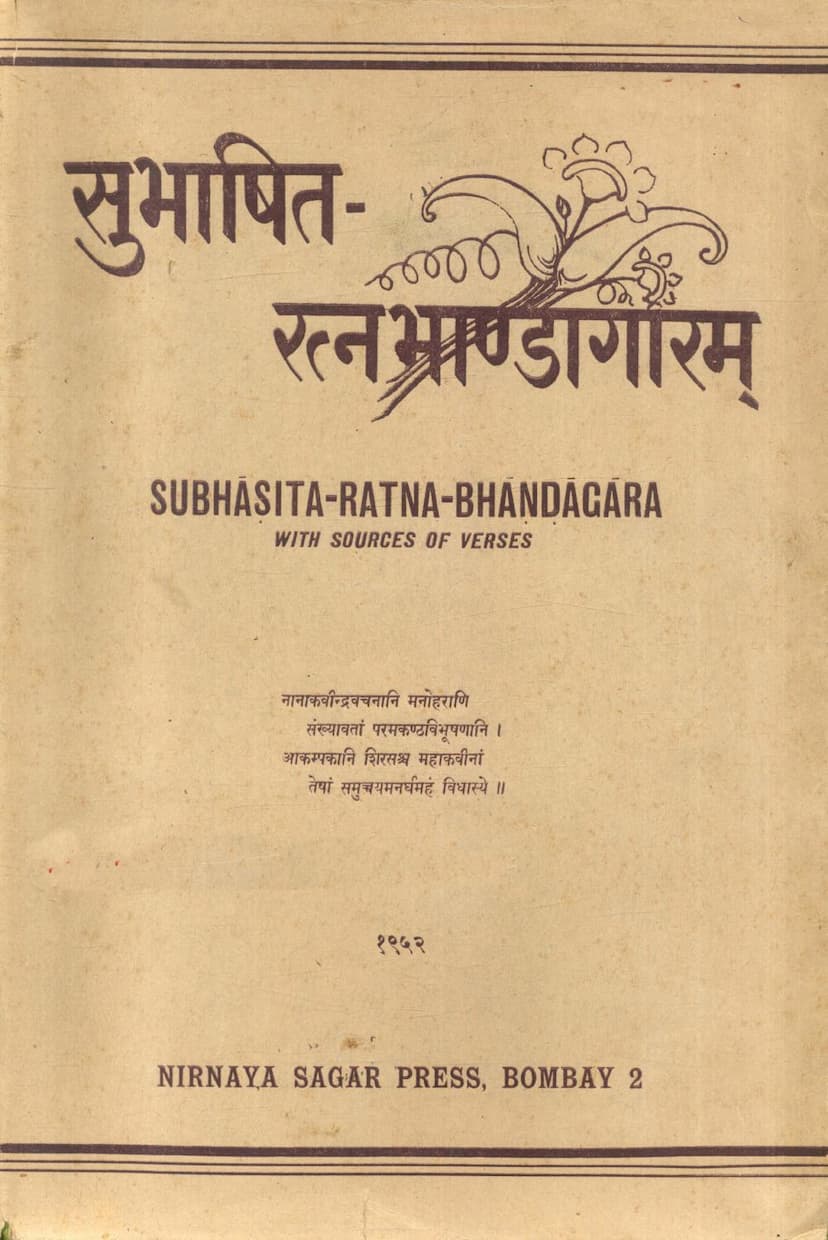Subhashit Ratna Bhandagaram
Added to library: September 2, 2025
Loading image...

Summary
The book "Subhashita Ratna Bhandagaram" by Narayanram Acharya, published by Nirnaya Sagar Press, is an extensive collection of witty, epigrammatic, instructive, and descriptive verses from Sanskrit poetry. This comprehensive anthology aims to present the essence of classical Sanskrit literature, with a particular focus on the richness of its secular thought and emotion.
Key Features and Content:
- Extensive Collection: The book is renowned for being one of the largest known collections of Sanskrit epigrams, encompassing lyric and gnomic verses.
- Essence of Sanskrit Literature: It serves as a distillation of classical Sanskrit literature, including verses from various forms like kāvyas, dramas, and puranas.
- Moral and Sententious Weight: A significant proportion of the verses carry a moral or sententious weight, making them popular as bywords, adages, and maxims across Indian languages.
- Sources Cited: A notable feature of this edition (compared to earlier ones) is the inclusion of sources for the epigrams, allowing readers to trace the verses to their origins, although acknowledging the difficulty of tracing every single stanza due to their long circulation.
- Structure and Content: The book is organized into several prakaranas (chapters) covering a wide range of topics, including:
- Mangalacharanaprakaranam (Invocation Chapter): Contains verses dedicated to auspicious beginnings and invocations to deities like Brahma, Vishnu, Shiva, Ganesha, Saraswati, and Parvati.
- Samanya Prakaranam (General Chapter): Discusses the praise of poetry, verses, grammar, drama, and various poets and scholars (e.g., Kalidasa, Bhavabhuti, Dandin, Mayura, Amarasingha, Rajasekhara, Banabhatta). It also covers moral themes such as praise and criticism of wealth, charity, greed, contentment, courage, humility, truth, and human character.
- Raja Prakaranam (Royal Chapter): Features verses related to kings, their courts, administration, military affairs, descriptions of processions, battles, and the qualities of rulers and their officials. It includes references to numerous historical and legendary rulers.
- Chitra Prakaranam (Miscellaneous/Artistic Chapter): This section contains verses that are artistically constructed or play with language, such as "samasyakhyaana" (enigmatic verses), "matraachyutaka" (verses with dropped vowels), "binduchyutaka" (verses with dropped dots), "kutaani" (riddles), "kriyagupta" (verses where actions are hidden), and "bhasha" (language descriptions).
- Anyokti Prakaranam (Allegorical Chapter): This extensive section comprises verses using "anyokti" or indirect speech, drawing parallels from nature, animals, objects, and natural phenomena to convey moral or instructive messages. It covers a vast array of subjects, from celestial bodies like the Sun and Moon to mountains, rivers, oceans, trees, plants, animals, and even abstract concepts personified.
- Nava Rasa Prakaranam (Nine Sentiments Chapter): This chapter delves into the nine rasas (aesthetic sentiments) of Sanskrit poetics, particularly focusing on descriptions related to Shringara Rasa (love and beauty), including detailed descriptions of feminine beauty, separation, longing, and reunion. It also touches upon other rasas like Veera (heroism) and Karuna (pathos).
- Sankirna Shlokah (Miscellaneous Verses): A concluding section of miscellaneous verses.
- Editor's Contribution: The eighth edition, re-edited by Narayanram Acharya, aimed to improve upon earlier editions by dropping less meritorious stanzas and replacing them with more forceful or charming ones, adding a seventh prakarana on miscellaneous topics, and meticulously citing sources where possible.
- Educational Philosophy: The introduction highlights a concern for modern Indian education's tendency to reduce Sanskrit study to rote memorization for examinations, contrasting it with the collection's purpose of exposing readers to the "variety of secular thought and emotion transmitted to us by our ancestors."
In essence, "Subhashita Ratna Bhandagaram" is a treasure trove of Sanskrit poetic wisdom, designed to be both enlightening and aesthetically pleasing, offering a window into the intellectual and emotional landscape of ancient India.